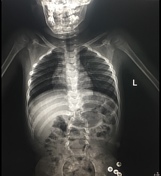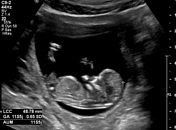42 results found
Case
Spina bifida

Published
04 Jan 2020
91% complete
X-ray
Case
Spina bifida: myeloschisis with Chiari II - prenatal diagnosis

Published
17 Apr 2018
94% complete
Ultrasound
Case
Spina bifida with tethered cord and myelomeningocele

Published
12 Nov 2023
80% complete
MRI
Case
Spina bifida with lipomyelomeningocoele

Published
27 Apr 2012
62% complete
MRI
Article
Diastematomyelia
Diastematomyelia, also known as a split cord malformation, refers to a type of spinal dysraphism (spina bifida occulta) when there is a longitudinal split in the spinal cord.
Terminology
Although traditionally it has been distinguished from diplomyelia (in which the cord is duplicated rather ...
Article
Banana sign (cerebellum)
The banana sign is one of the many notable fruit inspired signs.
This sign is seen on axial imaging through the posterior fossa of fetuses with associated conditions such as Chiari II malformation and/or spina bifida.
In Chiari II malformation, the banana sign describes the way the cerebellum...
Article
Spinal dysraphism
Spinal dysraphisms refer to a broad group of malformations affecting the spine and/or surrounding structures in the dorsum of the embryo. They are a form of neural tube defect.
Pathology
The neural tube is formed by the lengthwise closure of the neural plate, in the dorsum of the embryo.
The ...
Article
Craniorachischisis
Craniorachischisis, also known as craniorachischisis totalis, is a rare birth defect and the most severe of the neural tube defects. It refers to the presence of both anencephaly and spina bifida.
Epidemiology
In one study the prevalence of craniorachischisis was 0.51 per 10,000 live births in...
Article
Tethered cord syndrome
Tethered cord syndrome is a neurological disorder caused by tissue attachments that limit the movement of the spinal cord within the spinal canal.
Clinical presentation
Tethered cord syndrome is a clinical diagnosis based on neurologic deterioration involving the lower spinal cord 7. Patients ...
Article
Edwards syndrome
Edwards syndrome, also known as trisomy 18, along with Down syndrome (trisomy 21) and Patau syndrome (trisomy 13), make up the only three autosomal trisomies to be compatible with extrauterine life in non-mosaic forms, albeit in the case of Edward syndrome only for a week or so.
Epidemiology
...
Article
Sprengel deformity
Sprengel deformity, or congenital elevation of the scapula, is a complex deformity of the shoulder and is the most common congenital shoulder abnormality. An initial diagnosis can often be made on radiographs, but CT or MRI is often necessary to evaluate the details of the abnormality.
Epidemio...
Article
Patau syndrome
Patau syndrome (also known as trisomy 13) is considered the 3rd commonest autosomal trisomy.
Patau syndrome, Down syndrome (trisomy 21), and Edwards syndrome (trisomy 18) are the only three trisomies compatible with extrauterine life. However, few infants with either Patau or Edwards syndrome l...
Article
Congenital talipes equinovarus
Congenital talipes equinovarus is considered the most common anomaly affecting the feet diagnosed on antenatal ultrasound.
Terminology
While some use talipes equinovarus and clubfoot synonymously, in certain publications, the term clubfoot is considered a more general descriptive term that des...
Article
Aicardi syndrome
Aicardi syndrome is a rare severe developmental disorder. It results from an X-linked genetic defect that is fatal in males and therefore only manifests in females (except for rare 47, XXY cases).
Terminology
Aicardi syndrome is distinct from Aicardi-Goutieres syndrome although both are named ...
Article
Butterfly vertebra
Butterfly vertebra, also sometimes known as a sagittal cleft vertebra or anterior rachischisis, is a type of vertebral anomaly that results from the failure of fusion of the lateral halves of the vertebral body because of persistent notochordal tissue between them.
Pathology
Butterfly vertebra...
Article
Spinal neurenteric cyst
Spinal neurenteric cysts are a rare type of foregut duplication cyst, accounting for ~1% of all spinal cord tumors. They are usually classified as spinal or intracranial and are associated with vertebral or CNS abnormalities respectively.
Pathology
Neurenteric cysts result from incomplete res...
Article
Lipomyelomeningocele
Lipomyelomeningoceles are one of the forms of closed spinal dysraphism. They usually present as a subcutaneous fatty mass just above the intergluteal cleft. However, some lipomyelomeningoceles may occur at other locations along the spinal canal.
Clinical presentation
Lipomyelomeningoceles may ...
Article
Tight filum terminale syndrome
Tight filum terminale syndrome, or tight filum syndrome, is a subtype of the tethered cord syndrome that is attributed to a thick, short, and/or otherwise inelastic filum terminale rather than other tethering agents.
Terminology
The term "tight filum terminale syndrome" is synonymous with "tet...
Article
Congenital diaphragmatic hernia
Congenital diaphragmatic herniation (CDH) accounts for a small proportion of all diaphragmatic herniae. However, it is one of the most common non-cardiac fetal intrathoracic anomalies.
Epidemiology
Congenital diaphragmatic hernias are seen in 1 of every 2000-4000 live births. 84% are left-side...
Article
Klippel-Feil syndrome
Klippel-Feil syndrome is a complex heterogeneous entity that results in cervical vertebral fusion. Two or more non-segmented cervical vertebrae are usually sufficient for diagnosis.
Epidemiology
There is a recognized female predilection 1. Klippel-Feil syndrome has an incidence of 1:40,000-42,...









 Unable to process the form. Check for errors and try again.
Unable to process the form. Check for errors and try again.